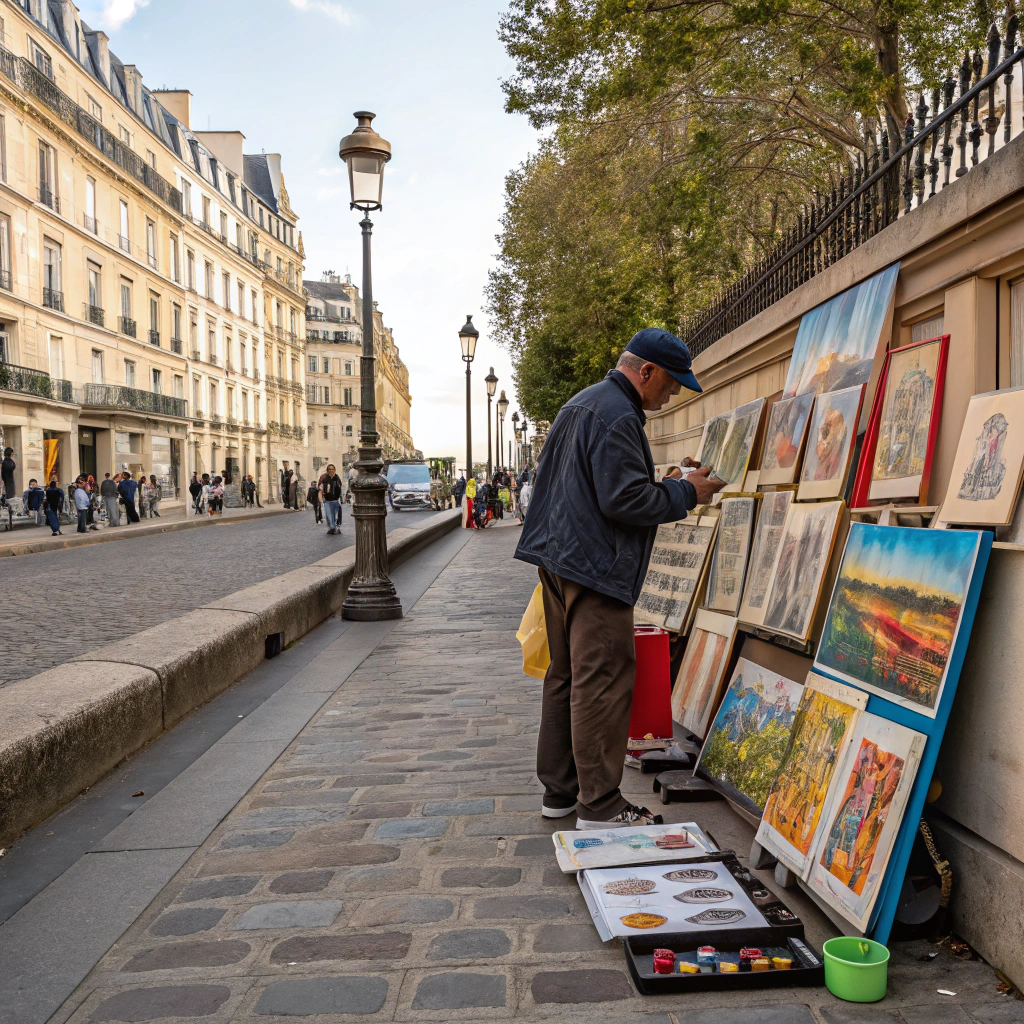
Wondering where to buy street art in Paris? The city is a canvas for numerous talented artists who bring life to public spaces with their creativity. Buying street art is not just about owning a unique piece; it’s also about supporting local artists and the culture of the city. Here are some of the top locations where you can buy street art in Paris.
Le Marais District
Le Marais is one of the most famous neighborhoods in Paris for street art. Its narrow streets are littered with colorful murals and graffiti. Here, you can find galleries that specialize in street art. Spots like Galerie Martel showcase the work of both established and emerging street artists. You’ll also find numerous shops that have partnered with local artists to produce limited-edition prints. Walking through Le Marais, you may even find pieces directly from the artists themselves as they create on the streets.
Belleville
Belleville is another hot spot for street art lovers. This district is known for its multicultural vibe and artistic community. The Belleville Street Art Tour offers guided excursions that take you through the best spots in the neighborhood. After the tour, you might want to visit Le 104, a cultural center that features exhibitions and often sells artworks directly from local artists. The prices vary, making it accessible for all types of art lovers.
Canal Saint-Martin
The Canal Saint-Martin area is not only picturesque but also brimming with creativity. Here, you can find murals along the canal and hidden pieces tucked away in alleyways. The Pop-Up Gallery sets up temporary exhibits in this district, allowing you to buy affordable and original street art made by local artists. Make sure to keep an eye out for pop-up exhibitions that showcase diverse artistic styles.
Montmartre
Known for its artistic history, Montmartre is home to many famous artists and street performers. As you stroll through the cobbled streets, take time to visit the local galleries like Galerie 22, which specializes in local street art. The prices range from prints to original pieces, catering to all budgets. Additionally, you may come across artists setting up their work in public spaces, giving you a chance to purchase directly from them.
Online Platforms
If you can’t visit Paris right now, or want to explore more options, consider online platforms. Websites like Artfinder and Saatchi Art feature countless street artists from Paris. You can browse their collections from the comfort of your home and find unique pieces to purchase. Many artists also sell their work on social media platforms like Instagram, making it easier for you to buy directly from them.
Local Fairs and Markets
Paris hosts several art fairs and markets throughout the year, where street artists come together to showcase their work. Check out events like the Paris Urban Art Fair, held annually, where you can find a plethora of street art to choose from. Alternatively, pop into the Marché aux Puces de Saint-Ouen, one of the largest antique markets in the world, where you can find vintage street art pieces and exciting local works.
Be Cautious
While exploring these areas, ensure you are purchasing legitimate works. Support artists directly by asking for authenticity certificates whenever possible. This not only ensures you’re getting real street art but also helps you connect with the artist and understand their journey. Additionally, discussions about art with local artists can give you insights into the culture and scene of street art in Paris.
Whether you’re a seasoned collector or just starting, buying street art in Paris can be an enriching experience. From hidden gems in neighborhoods to popular online platforms, there are plenty of ways to find stunning works that resonate with you. Embrace the vibrancy of Parisian street art and support the artists who make this city a colorful masterpiece.
Understanding the Different Styles of Street Art
Street art is a vibrant expression of culture and identity, often representing the voice of the community or the individual artist. In cities around the world, street art can take on many different styles, each carrying its unique message and aesthetic. Understanding these styles can enhance your appreciation of this dynamic art form and may even inspire you to explore local street art scenes.
Graffiti
One of the most recognized forms of street art is graffiti. Known for its bold colors and often intricate lettering, graffiti started in urban landscapes as a way for artists to express their thoughts and feelings. The use of spray paint is common, and the results range from simple tags to extensive murals. Many graffiti artists employ their own stylistic interpretations of letters and shapes, which can make their work easily identifiable.
Stencils
Stencil art is another popular style in the street art world. This technique involves cutting out shapes or designs from a material, allowing paint to be sprayed or rolled through. Artists like Banksy have popularized stencil art, creating iconic images and social commentary. Stencil pieces often feature strong political or social messages, making them thought-provoking as well as visually striking.
Posters and Wheatpasting
Posters, often made from paper and using a technique called wheatpasting, offers street artists a different canvas. These artworks can convey complex stories and themes and are usually quicker to produce than murals. Artists use this medium for both artistic and commercial purposes, with many benefiting from the ease of making multiple copies of their work. Expect to see everything from abstract designs to portraits in this format.
Sticker Art
Sticker art involves artists creating unique and sometimes humorous designs that they place around the city. This style is particularly accessible since anyone can print their own stickers. The intimacy of sticker art adds a layer of interaction with the viewer, as many stickers are designed to blend into their surroundings. Collecting and exchanging stickers has also become a common hobby within this community.
Mosaics
Mosaic street art incorporates tiles, glass, or other materials to create a cohesive piece. This style reflects a more traditional craft method often associated with historic art but gives it an urban twist. Street artists who work with mosaics typically spend considerable time placing each piece to ensure it fits together correctly. These mosaics often have a tactile quality that draws viewers in, inviting them to approach the artwork closely.
Illusions and 3D Art
Illusionistic artworks create a three-dimensional effect on flat surfaces, tricking the eye into perceiving depth. This area of street art often employs clever techniques that interact with the surrounding environment, making the piece appear life-like. These artworks can range from playful scenes to thought-provoking imagery, engaging passersby in a unique way.
Installation Art
Unlike other styles, installation art can involve multiple mediums and materials, transforming public spaces into an art exhibit. Artists might use found objects, lights, or sound elements to create immersive experiences. These installations often prompt viewers to rethink their surroundings and encourage interaction, providing a fresh way to engage with urban environments.
Street Art Photography
While not a form of street art in the traditional sense, photography of street art plays an essential role in documenting and sharing these public creations. Many photographers focus solely on capturing street art, emphasizing the transient nature of these pieces. This style helps preserve artworks that may soon be painted over or removed, allowing for wide dissemination and appreciation via social platforms.
As you explore the diverse range of street art styles, consider how each form reflects the cultural and social contexts of its environment. From graffiti to mesmerizing 3D illusions, each piece has its own story to tell. Take the time to engage with the artwork you encounter, and you’ll find a deeper connection to the artistic expressions that color our urban spaces.
Tips for Choosing Authentic Street Art Pieces
When you’re on the hunt for authentic street art pieces, you want to make sure you’re investing in something genuine and meaningful. With a little guidance, you can navigate the vibrant world of street art and find pieces that resonate with you. Here are some tips to help you choose authentic street art pieces that reflect both the artist’s style and your personal taste.
Know the Artist
Before committing to a purchase, take some time to learn about the artist behind the piece. Many street artists have established backgrounds and distinctive styles. Here’s how to go about it:
- Research the Artist: Look for credible sources that profile street artists. Websites, social media pages, and interviews are great places to gather information.
- Explore Their Previous Works: Understanding the artist’s signature style will help you identify authenticity. Pay attention to recurring themes and techniques.
Check the Provenance
Provenance refers to the history of ownership of the art piece. It’s crucial for verifying authenticity. When you find a piece you love, make sure to ask for details about its origin:
- Gallery Representation: Verify if the artist is represented by a reputable gallery. Galleries often provide certificates of authenticity for the works they sell.
- Documentation: Request information about previous ownership, exhibitions, and related events. This can boost the credibility of the piece you’re considering.
Understand the Market
The street art market can be tricky to navigate, filled with reproductions and derivative works. By understanding the market, you can better identify authentic street art:
- Pricing Trends: Familiarize yourself with common price ranges for the artists you’re interested in. If a piece seems too cheap, it might not be authentic.
- Join Communities: Engage with street art communities online or in-person. Sharing insights and experiences with other enthusiasts can enhance your understanding.
Look for Unique Features
Authentic street artists often incorporate unique elements into their work. When evaluating pieces, be on the lookout for:
- Personal Touches: Many artists add personal signatures, dates, or specific motifs that are recognizable. Look for these distinctive features.
- Originality: Choose works that feel original rather than mass-produced. The charm of street art lies in its uniqueness.
Trust Your Instincts
Your emotions play an important role when selecting art. Trust your instincts—if a piece speaks to you, it likely has value beyond its price tag. Here are some ways to enhance your decision-making:
- Follow Your Aesthetic: Choose pieces that resonate with your taste. You’ll want to enjoy the art in your space long-term.
- Visual Impact: Consider how the piece looks in person. Photos can sometimes misrepresent colors or details.
Inspect the Condition
Before purchasing any piece, inspect its condition. An authentic street art piece should be in good shape, reflecting its artistic value:
- Physical Integrity: Look for damage like tears or fading. These can affect both the aesthetic appeal and investment value.
- Quality of Materials: Authentic artworks often use high-quality paints and materials. Ask about the mediums used to create the piece.
Purchase from Reputable Sources
Choosing where to buy is just as important as the piece itself. Aim to purchase from reputable galleries, artists’ websites, or respected online platforms specializing in street art. Avoid informal street vendors unless you’re familiar with their reputation. Remember, authenticity is key!
Ultimately, the journey of finding authentic street art is as rewarding as the piece you end up with. Trust your instincts, do your research, and choose a piece that brings joy and inspiration into your space. Enjoy exploring the vibrant art scene, and you’ll likely discover a treasure that’s truly unique to you.
The Role of Street Art in Parisian Culture
Street art in Paris is not just a form of expression; it is a vital thread in the cultural fabric of the city. As you stroll through neighborhoods like Le Marais, Montmartre, or the Canal Saint-Martin, vibrant murals and stencils greet you at every turn. This urban canvas reflects Parisian life, encapsulating its history, politics, and social dynamics.
The streets of Paris have long been a stage for artists and activists alike. Street art emerged as a powerful tool for identity and resistance, engaging both locals and visitors. It allows passionate creators to communicate messages that might otherwise go unheard. From playful depictions of everyday life to thought-provoking political statements, each piece tells its own unique story. This rich diversity is what makes the street art scene in Paris so captivating and accessible.
You might be wondering what kinds of street art you can find in Paris. Here’s a glimpse:
- Murals: Large and colorful works can be found on building facades, often celebrating local history or culture.
- Stickers: Small, often humorous artworks that pop up on various surfaces. These can range from simple graphics to complex designs.
- Stencils: Quick and impactful designs, usually created with spray paint, that convey strong messages.
- Sculptures: Some artists interact with the environment, creating three-dimensional works that enhance existing urban settings.
The significance of street art in Parisian culture goes beyond the aesthetic. Many artists use their work as a platform for social commentary. Issues such as immigration, gentrification, and climate change often take center stage in different artworks, sparking conversations on critical topics. One notable artist, Banksy, has left his mysterious mark in the city, drawing attention to the plight of refugees with poignant pieces that resonate with both locals and tourists.
You may find yourself asking where to start your street art adventure in Paris. Here are some key neighborhoods to explore:
- Le Marais: Known for its eclectic mix of art galleries and boutiques, this area is home to some captivating murals.
- Montmartre: Famous for its artistic past, you will find a blend of classic and contemporary street works.
- Canal Saint-Martin: A trendy area boasting an ever-evolving landscape of street art that reflects the youthful spirit of its surroundings.
- Belleville: The city’s multicultural vibe is visualized in its rich tapestry of street art, representing various cultural narratives.
Street art plays a fundamental role in the ongoing dialogue of Parisian life, bridging gaps between cultures and generations. It invites everyone into a shared experience, encouraging you to stop, observe, and become part of the vibrant history unfolding around you. Whether you’re an art lover or a casual observer, the street art scene in Paris offers something for everyone, allowing you to engage with both the artwork and the city’s spirit itself.
Navigating the Paris Art Scene: Galleries vs. Street Markets
Paris, the city of lights, is rich in art and culture. Whether you’re a seasoned art collector or just starting your journey, understanding the difference between galleries and street markets can enhance your experience. Each offers a distinctive way to explore and acquire artwork, catering to various tastes and budgets.
Galleries: A Polished Experience
Visiting galleries in Paris provides a refined art experience. Typically, galleries showcase works from established and emerging artists, making it a great step for buyers looking for quality and credibility. They often feature a blend of mediums like paintings, sculpture, and photography.
- Curated Collections: Galleries present carefully curated collections that reflect a specific theme or movement.
- Expert Guidance: Many galleries have knowledgeable staff who can provide insights into the artwork and the artists, helping buyers make informed decisions.
- Exhibited in Comfort: Enjoy the ambiance and calm of a gallery space that allows you to take your time with each piece.
When visiting galleries, it’s beneficial to ask questions. Don’t hesitate to inquire about the artist’s background, the inspiration behind their work, and any upcoming exhibitions. This engagement not only enhances your understanding but can also lead to discovering hidden gems.
Street Markets: The Pulse of Local Art
If you’re looking for something unique and affordable, Paris street markets are the way to go. These markets often feature a diverse range of artworks, from prints and sketches to handmade crafts. Here’s what to expect at a street market:
- Authenticity: Buying street art often means getting pieces directly from the artist, adding a personal touch to your purchase.
- Negotiable Prices: Prices at street markets can often be negotiated, allowing you to acquire art at a price that fits your budget.
- Vibrant Atmosphere: Street markets are alive with energy. The hustle and bustle create an engaging environment that enhances the art-buying experience.
Some of the most popular street markets in Paris include the famous Montmartre Market and the Place du Tertre, where local artists showcase their talents. Here, you’ll find everything from traditional oil paintings to contemporary street art. It’s a fantastic way to immerse yourself in the local art scene.
Comparing the Two: Which is Right for You?
Choosing between galleries and street markets depends on what you’re looking for:
- If You Value Quality: Galleries offer a platform for established artists with a specific focus on quality and authenticity. You are likely to find art that holds value over time.
- If You’re Seeking Affordability and Variety: Street markets provide a broader spectrum of options at varying price points. This is perfect for first-time buyers or those looking to decorate their homes without breaking the bank.
- If You Enjoy the Process: Street art markets encourage conversation with artists, adding a personal story to your piece, which often enhances the emotional value.
In contrast, galleries provide a more sophisticated purchasing environment, where art is treated as an investment rather than just a decoration.
Where to Experience Both?
Fortunately, Paris is home to numerous areas where you can experience both galleries and street markets. The artsy neighborhood of Le Marais has a mix of trendy galleries and quirky boutiques. You can stroll through streets lined with art while popping into galleries that exhibit remarkable works.
Additionally, events like the Nuit Blanche (White Night) showcase street art alongside gallery exhibitions, creating a marriage of the two worlds. This annual event invites artists from all disciplines to set up exhibits all over the city, giving you a taste of both traditional and contemporary art in a seamless celebration.
In the end, both galleries and street markets offer unique perspectives on the Paris art scene. Depending on your preferences—be it a high-caliber classical environment or an energetic street vibe—you’ll find something that resonates with you. Embrace the journey of exploring both avenues to truly appreciate the artistic spirit of Paris.


